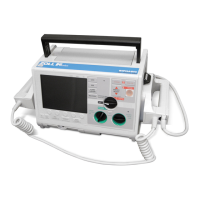M Series Service Manual
9650-0450-01 Rev. U 4-7
CPU and EPU
The Main System Board contains two microprocessors. A Motorola HC-11 single chip microprocessor is used to acquire, convert and process ECG
signals, (ECU). An Hitachi SH-3 RISC microprocessor acts as the system’s main CPU. The SH-3 CPU and has an integrated on-chip multiplier, a
cache memory, a memory management unit as well as data protection and virtual memory functions. It also has a timer, a real time clock, an
interrupt controller, a serial communication interface (SCI), and other peripheral functions necessary for the system operation. The memory
circuitry includes Flash ROM, internal flash non-volatile memory and DRAM.
The EPU acquires ECG data and runs the A/D convertor that se
nds data in the form of a serial stream to the CPU.
High Voltage Module
The High Voltage (HV) module includes the high voltage circuitry required for pacing and defibrillation, including the defib charge circuitry, solid
state patient relay, safety relay, defib capacitor, defib choke and front end protection circuitry for the MFC ECG. There are two different types of
HV Modules: a damped sinusoidal waveform HV module and a Biphasic (HV) module.
The following table describes the high voltage board components:
Component Function
Solid State Patient Relay Controls the delivery of therapeutic energy to patient.
Safety Relay Discharges Defib capacitor into the internal discharge
resistor when defibrillator is not in use.
Defibrillator Capacitor Stores energy for therapy.
Defibrillator Choke Conditions waveform delivered to the patient.(DSW)
Front End Protection Circuitry for
the MFC ECG
Protects ECG front end against defibrillator pulses.
Monophasic HV Provides damped sinusoidal waveform therapeutic
energy. (Monophasic units only.)
Biphasic HV Provides biphasic waveform therapeutic energy.
(Biphasic units only.)

